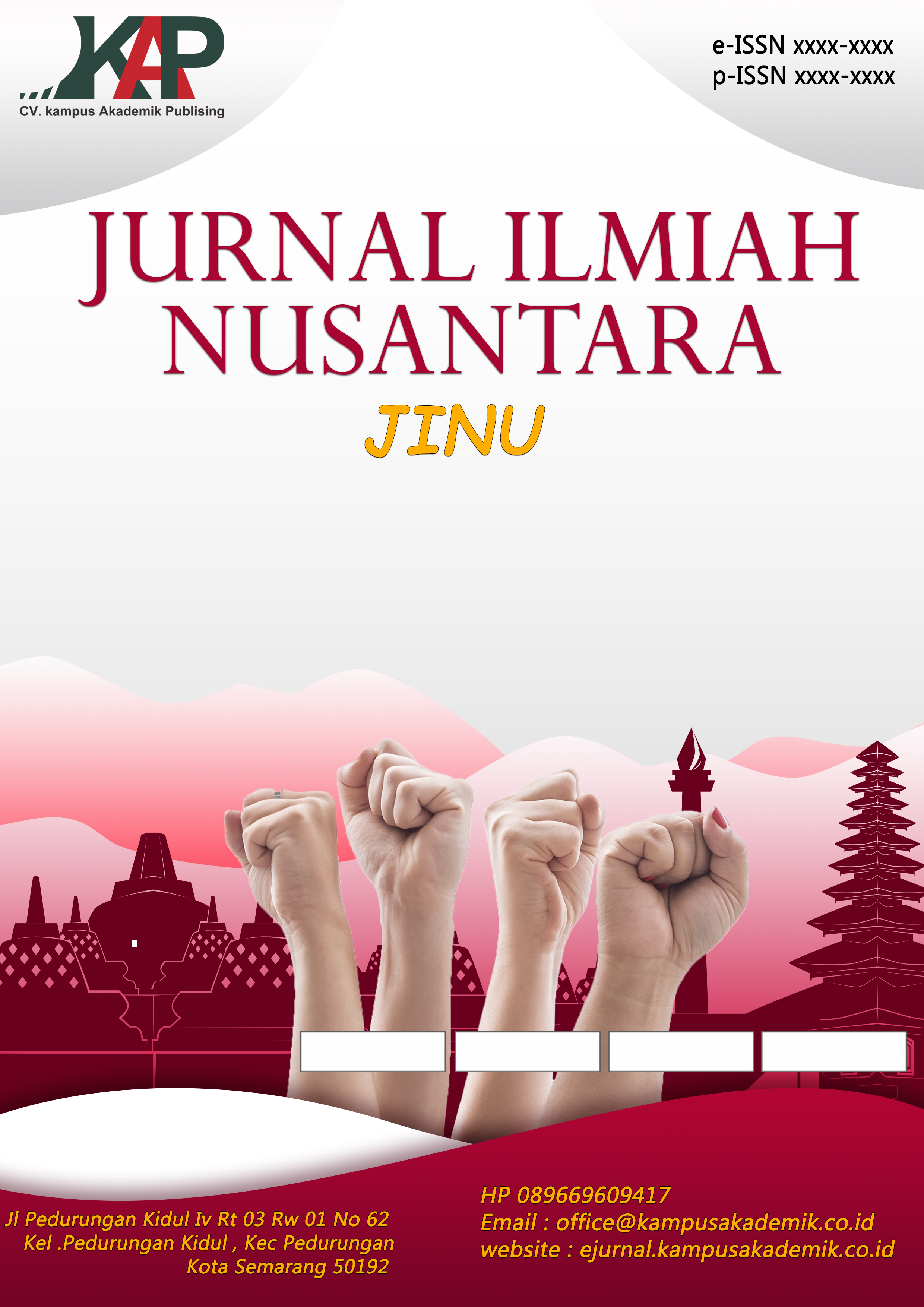PENGARUH PENGGUNAAN WHATSAPP GROUP TERHADAP EFEKTIVITAS KOMUNIKASI RT-RW DI KECAMATAN PATIKRAJA
DOI:
https://doi.org/10.61722/jinu.v2i3.5680Keywords:
Communication effectiveness, phenomenology, digital communication.Abstract
This study aims to gain an in-depth understanding of the influence of WhatsApp Group usage on the effectiveness of communication between neighborhood unit (RT) and community unit (RW) administrators in Patikraja Subdistrict, Banyumas Regency. In the context of shifting community communication patterns due to the development of digital technology, WhatsApp has become a widely used communication medium in social life at the community level. This research employs a qualitative method with a phenomenological approach to explore the subjective experiences of neighborhood administrators and residents regarding the use of WhatsApp Groups as a communication tool. Data collection was carried out through in-depth interviews with eight informants consisting of RT heads, RW heads, and residents who are active in neighborhood WhatsApp Groups. The data obtained were analyzed using phenomenological stages, namely data reduction, theme formulation, and extraction of the essential meanings from the participants’ lived experiences. The findings show that the use of WhatsApp Groups plays a role in improving communication effectiveness, particularly in terms of the speed of information dissemination, activity coordination, and resident participation. The conclusion of this study indicates that WhatsApp Groups are not merely communication tools, but have become digital social spaces that influence the dynamics of interaction among residents. Therefore, there is a need to improve digital literacy and communication ethics training to ensure that this technology is used more effectively in supporting community-based communication development.
References
Castells, M. (2010). The Rise of the Network Society. Wiley-Blackwell.
Effendy, O. U. (2015). Ilmu Komunikasi Teori dan Praktek. PT Remaja Rosdakarya.
Fauziah, N., & Rizal, M. (2023). “Triangulasi dalam Studi Kualitatif Komunikasi Warga Berbasis Media Sosial.” Jurnal Kajian Komunikasi Komunitas, 6(2), 89–103.
Firdaus, A., & Haryanto, S. (2018). Nilai budaya dan komunikasi masyarakat dalam pembangunan daerah. Jurnal Komunikasi dan Budaya, 7(1), 27-38.
Handayani, I., & Supriyanto, E. (2021). “Peran Observer dalam Penelitian Kualitatif Komunitas WhatsApp.” Jurnal Metodologi Sosial Humaniora, 4(1), 22–34.
Handayani, S., & Nugroho, Y. (2019). Efektivitas komunikasi dalam koordinasi kegiatan sosial di tingkat RT. Jurnal Administrasi Publik, 15(3), 120-131.
Hidayati, L., & Prasetya, N. (2023). “Etika Komunikasi Digital dalam Grup WhatsApp Komunitas.” Jurnal Etika dan Media Sosial, 3(2), 40–52.
Katz, E., Blumler, J. G., & Gurevitch, M. (1974). Uses and Gratifications Research. The Public Opinion Quarterly.
Kurniawan, A., & Aziz, R. (2021). "Efektivitas WhatsApp dalam Komunikasi Lingkungan RT di Perkotaan." Jurnal Komunikasi Masyarakat, 9(2), 102–116.
Mustika, R. (2021). “Pemanfaatan WhatsApp Group dalam Komunikasi RT di Kota Bekasi.” Jurnal Ilmu Komunikasi Sosial, 4(3), 103–115.
Prasetya, D., & Nugroho, A. (2020). "Dominasi Komunikasi Satu Arah dalam Grup WhatsApp RT." Jurnal Komunikasi Sosial Digital, 6(3), 130–145.
Prasetyo, A., & Sari, D. (2023). “Statistik Penggunaan Aplikasi Komunikasi di Indonesia.” Jurnal Teknologi Informasi dan Komunikasi, 5(2), 22–33.
Prasetyo, A., & Sulastri, R. (2020). Pemanfaatan WhatsApp Group dalam Komunikasi Warga di Tingkat RT. Jurnal Komunikasi Masyarakat, 2(1), 45–58.
Putra, F. R. (2019). Peran WhatsApp Group dalam Komunikasi Komunitas RT di Desa. Jurnal Ilmu Komunikasi, 17(2), 123–134.
Putra, I. G. N. A., & Lestari, D. (2021). Komunikasi digital sebagai sarana penyebaran informasi di lingkungan RT-RW. Jurnal Teknologi Informasi dan Komunikasi, 9(1), 50-63.
Rahardjo, D., & Wibowo, B. (2020). “Komunikasi Digital dalam Masa Pandemi: Peran WhatsApp Group dalam Kohesi Sosial.” Jurnal Komunikasi dan Masyarakat, 7(1), 55–68.
Rahman, T. (2020). Komunikasi Efektif dalam Organisasi Kemasyarakatan. Jurnal Komunikasi Organisasi, 4(1), 56–68.
Ramadhani, Y., & Sari, M. (2023). "Modul Literasi Digital Berbasis Kearifan Lokal untuk Komunitas Marginal." Jurnal Teknologi dan Pemberdayaan Masyarakat, 7(1), 25–38.
Santika, R., Wijaya, M., & Harahap, A. (2024). Keamanan data dan privasi dalam aplikasi layanan masyarakat berbasis digital. Jurnal Teknologi Informasi, 12(1), 45-59.
Santoso, D., Prabowo, B., & Kusuma, T. (2022). Pemanfaatan media sosial dalam meningkatkan komunikasi RT-RW. Jurnal Komunikasi Massa, 14(4), 87-101.
Sari, P. M., & Lestari, R. (2023). Penguatan Literasi Digital untuk Pengurus RT dalam Pengelolaan Grup WhatsApp. Jurnal Pengabdian Masyarakat, 6(1), 78–86.
Sari, R. D., & Gunawan, T. (2020). “Makna Komunikasi Digital dalam Kegiatan Sosial Komunitas Lokal.” Jurnal Komunikasi dan Budaya, 7(1), 45–59.
Siregar, R., & Latifah, I. (2020). “Literasi Digital di Tingkat Komunitas: Studi Kasus Penggunaan WhatsApp RT.” Jurnal Media dan Literasi Digital, 4(1), 19–34.
Utami, S. (2022). Etika Komunikasi di Media Sosial WhatsApp Group. Jurnal Komunikasi Digital, 5(2), 34–44.
Walther, J. B. (2011). Theories of Computer-Mediated Communication and Interpersonal Relations. In The Handbook of Interpersonal Communication (4th ed.). SAGE.
Wibowo, T., & Anggraini, R. (2020). Literasi digital masyarakat dan tantangan komunikasi di lingkungan RT. Jurnal Ilmu Komunikasi, 8(3), 210-223.
Wibowo, Y., & Cahyono, H. (2021). Efektivitas WhatsApp Group dalam Komunikasi Warga. Jurnal Komunikasi Digital, 3(1), 12–21.
Yuliana, D., & Permana, A. (2019). “Pendekatan Fenomenologi dalam Penelitian Komunikasi Digital Komunitas.” Jurnal Ilmu Komunikasi Nusantara, 5(2), 101–113.
Yuliani, T., & Aditya, R. (2022). “Partisipasi Warga dalam WhatsApp Group dan Keterlibatan Sosial di Komunitas Perkotaan.” Jurnal Komunikasi Sosial Humaniora, 9(2), 60–73.
Yulianti, L., & Prabowo, B. (2023). Pemanfaatan WhatsApp Group pada Masyarakat Perdesaan. Jurnal Komunikasi Sosial, 7(1), 22–33.
Downloads
Published
Issue
Section
License
Copyright (c) 2025 JURNAL ILMIAH NUSANTARA

This work is licensed under a Creative Commons Attribution-ShareAlike 4.0 International License.













